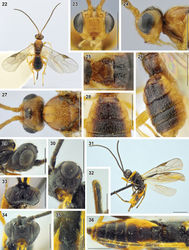Bracon imbricatellus
| Notice: | This page is derived from the original publication listed below, whose author(s) should always be credited. Further contributors may edit and improve the content of this page and, consequently, need to be credited as well (see page history). Any assessment of factual correctness requires a careful review of the original article as well as of subsequent contributions.
If you are uncertain whether your planned contribution is correct or not, we suggest that you use the associated discussion page instead of editing the page directly. This page should be cited as follows (rationale):
Citation formats to copy and paste
BibTeX: @article{Samartsev2021JournalofHymenopteraResearch83, RIS/ Endnote: TY - JOUR Wikipedia/ Citizendium: <ref name="Samartsev2021Journal of Hymenoptera Research83">{{Citation See also the citation download page at the journal. |
Ordo: Hymenoptera
Familia: Braconidae
Genus: Bracon
Name
Bracon imbricatellus Tobias, 2000 – Wikispecies link – Pensoft Profile
Material
South Korea (4 females). – Gyeonggi-do • 1 female; Suwon-si, [36] Jangan-gu, Pajang-dong, Gwanggyosan Mountain; 22 Jul. 1998; D.-S. Ku leg.; light trap; SMNE 943 • 1 female; Suwon-si, [37] Gwonseon-gu, Seodun-dong, Yeogisan Mountain; 31 Jul. 1995; June-Yeol Choi leg.; Malaise trap; SMNE 944 • 1 female; same data as for preceding; 14 Aug. 1995; ZISP 937 • 1 female; same data as for preceding; NIBR 938.
Additional material
Japan – Fukushima Prefecture • 1 female (holotype); Hinoemata; 16–18 Aug. 1999; S.A. Belokobylskij leg.; ZISP.
Distribution
Japan: Honshu. South Korea (new record).
Description
Female. Fore wing length 2.6–3.0 mm. Width of head (dorsal view) 1.7–1.8× its median length. Transverse diameter of eye (dorsal view) 1.6–2.0× longer than temple. OOL 2.0–2.8× Od; POL 1.2–1.8× Od; OOL 1.6–1.7× POL. Longitudinal diameter of eye (lateral view) 1.3–1.6× its transverse diameter; hind margins of eye and temple subparallel. Face width 1.4–1.5× combined height of face and clypeus. Longitudinal diameter of eye 3.1–3.3× longer than malar space (anterior view). Malar suture weak under eye, smoothed near mandible. Width of hypoclypeal depression 1.2–1.4× distance from depression to eye. Antenna 0.90–0.95× as long as fore wing, with 24–25 antennomeres. First, middle and penultimate flagellomeres 2.0–2.1×, 1.7–2.0, and 1.8–2.2× longer than wide, respectively. Mesosoma 1.7–1.8× longer than its maximum height. Mesoscutum evenly, but sparsely setose. Notauli deep anteriorly, shallow and not united posteriorly. Mesepimeral and metapleural sulci smooth. Medio-longitudinal keel developed in apical third of propodeum, branching. Fore wing vein r arising from basal 0.40–0.45 of pterostigma; vein 1-R1 1.5–1.7× longer than pterostigma; marginal cell 12–16× longer than distance from its apex to apex of wing; vein 3-SR 2.0–2.5× vein r, 0.55–0.65× vein SR1, 1.3–1.4× vein 2-SR. Hind femur 3.0–3.4× longer than wide. Hind tibia without subapical row of thick setae. Fifth segment of hind tarsus 0.50–0.55× and 0.95–1.00× as long as hind basitarsus and second segment, respectively. Claws with acute angularly protruding basal lobe. First metasomal tergite with incomplete dorsal carina and developed dorsolateral carinae, its median length 0.70–0.85× its apical width. Second tergite with weak, narrow, longitudinal median area, weak anterolateral areas with smooth sculpture, and with deep s-shaped crenulate dorsolateral impressions bordered by long carinae; medially 1.1–1.5× longer than third tergite; its basal width 1.3–1.8× its median length. Second metasomal suture deep, curved and crenulate. Apical margins of third–sixth tergites thick, with weakly foveate transverse subapical grooves. Ovipositor sheath 0.85–1.00× as long as hind tibia and 0.23–0.25× as long as fore wing. Apex of ovipositor with weak nodus and ventral serration. Body mainly smooth; face medially and malar space granulate, face laterally and frons weakly granulate; propodeum posteriorly hardly coriaceous, with tree-like rugosity medially in posterior half; first metasomal tergite smooth to weakly foveate; second tergite areolate-rugose to foveate; third–sixth tergites smoothed foveate, or metasoma entirely areolate-rugose to foveate-rugose. Head and mesosoma mostly reddish brown with yellowish brown pattern, legs and lateral and ventral parts of metasoma reddish yellow; antenna basally reddish yellow, flagellum darkening apically; maxillary palps yellow; tegulae brownish yellow; propodeum and most of metasoma dorsally dark brown; wing membrane weakly darkened, pterostigma and veins brown.
Remarks
Relationships of the species are given below, in the diagnosis of B. virgatus Marshall.
Taxon Treatment
- Samartsev, K; Ku, D; 2021: New records of Braconinae (Hymenoptera, Braconidae) from South Korea Journal of Hymenoptera Research, 83: 21-72. doi
Images
|

